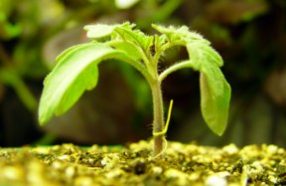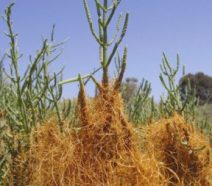Stalking Plants by Scent
A vine that feeds on other plants finds its victims by their smell.
Share this:
- Share via email (Opens in new window) Email
- Click to share on Facebook (Opens in new window) Facebook
- Click to share on X (Opens in new window) X
- Click to share on Pinterest (Opens in new window) Pinterest
- Click to share on Reddit (Opens in new window) Reddit
- Share to Google Classroom (Opens in new window) Google Classroom
- Click to print (Opens in new window) Print
Dodder is a wiry, orange vine that steals water and nutrients from other plants. Scientists have now found that this vine chooses its victim by smell, growing its shoots in the direction of a plant’s natural perfume.
 |
|
A seedling of a vine known as dodder attaches to a tomato plant. |
| Photo by Justin Runyon (courtesy of De Moraes and Mescher Labs) |
When a dodder seed sprouts, it doesn’t grow roots to seek its own food. Instead, it grows a shoot that reaches out to other plants, tapping them for food. The baby vine needs to find a host within a week to survive. It then grows into a spaghetti tangle that can even ensnare more than one plant.
Also known as strangleweed and witches’ shoelaces, dodders are listed among the 10 worst weeds in the United States. They can cost farmers millions of dollars by stunting their crops.
To figure out how a type of dodder vine known to prefer tomato plants finds a victim, scientists placed dodder sprouts near several possible targets. These targets included pots of moist soil, little jars of dyed water that created colored lights, young tomato plants, and even a cup of perfume made from chemicals that tomato plants give off.
 |
|
A dodder tangle steals food and water from a glasswort plant. |
| Photo by Collin Purrington (courtesy of De Moraes and Mescher Labs) |
Seedlings grew toward the tomato plant. They also reached out toward the cup of tomato perfume. They tended not to grow toward the moist soil or colored water.
The scientists then used a different setup, hiding the targets in chambers connected to dodder sprouts only by curving pipes, so the vine could find them only by smell. Dodder sprouts still grew toward their favored targets.
 |
|
The tendril of a young dodder plant stretches out to entwine a tomato seedling. |
| Photo by Justin Runyon (courtesy of De Moraes and Mescher Labs) |
By placing dodder sprouts near different plants, the scientists found that the type of dodder that they were studying prefers tomatoes and a flower called impatiens. And when given a choice between tomato and wheat, vine seedlings grow toward tomato.
The researchers then tested seven of the ingredients that make up tomato perfume separately. Dodder sprouts were attracted to three of them.
One of these ingredients turns up in wheat perfume, but the wheat perfume also contains a substance that repels dodder sprouts. This chemical could offer farmers one way to fight the vine and save their crops.—C. Gramling
Going Deeper:
Milius, Susan. 2006. Scent stalking: Parasitic vine grows toward tomato odor. Science News 170(Sept. 30):214. Available at http://www.sciencenews.org/articles/20060930/fob7.asp .
To learn more about research on dodder vines and how they respond to smell, see live.psu.edu/story/19800 (Penn State University).
To see a QuickTime movie of a dodder shoot growing toward a tomato plant, click here.
For additional information about dodder, go to
www.ipm.ucdavis.edu/PMG/PESTNOTES/pn7496.html and
plants.usda.gov/java/profile?symbol=CUPE3.
Science project ideas: Do all types of dodder vines rely on smell to find their hosts? How do various types of dodder vines differ in their preferences for plant hosts? Do any other parasitic plants find hosts by smell?







